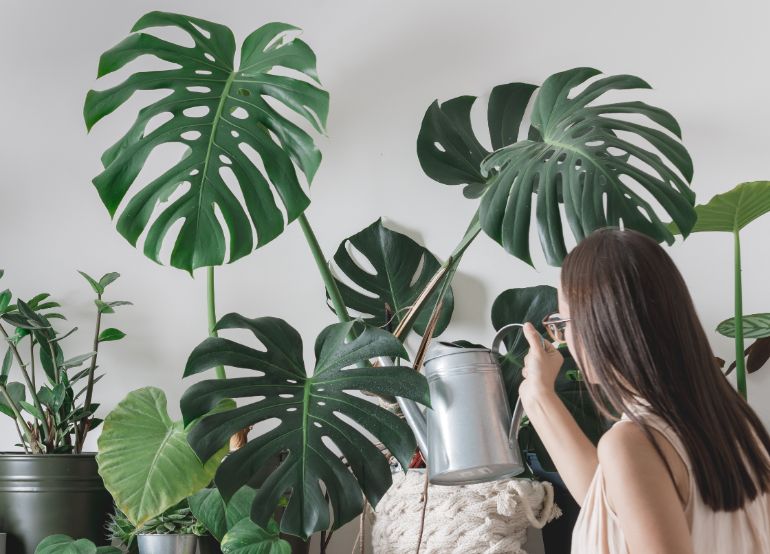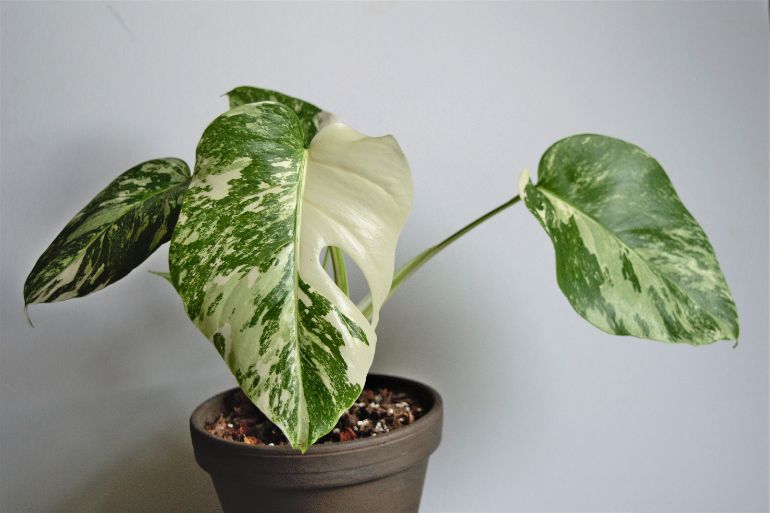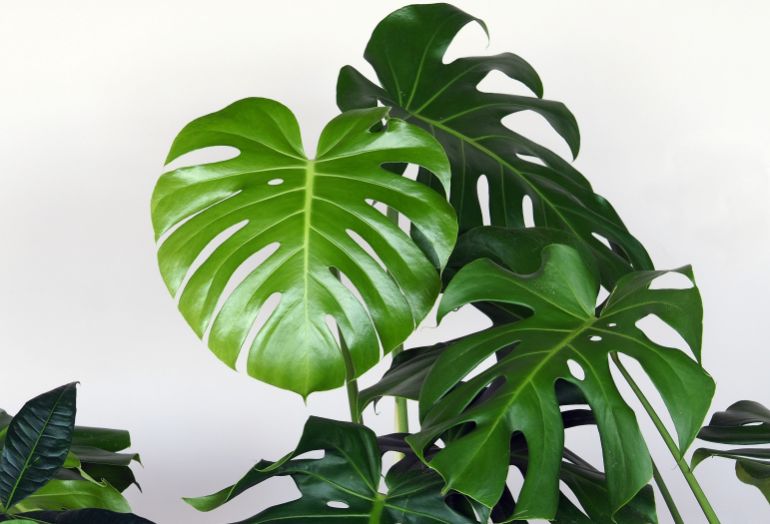If you’d like to learn how to water your Monstera houseplants correctly, you’ve come to the right place. Watering problems are common, and can really impact the health of your plants, so it’s crucial to get it right. This article will show you exactly how to water Monstera houseplants to make sure your plants thrive year after year.
Water Monstera once the top half of the potting soil is dry, but before the leaves droop and curl. Water thoroughly until the soil is evenly moist and water runs from the drainage holes. Use a well-draining pot and soil, and avoid letting the plant sit in water, as this will lead to root rot.
Watering Monstera is one of the most important aspects of care, but it’s also one of the most common causes of problems. Read on and I’ll show you the things that really matter.
How To Know When Your Monstera Needs To Be Watered
The most important thing to do is to check your plant regularly, and only water when the plant needs a drink, rather than watering on a schedule. Keeping your Monstera healthy is always a delicate balance between providing enough moisture for your plant, without causing waterlogged soil, which can lead to overwatering and root rot.
Here are the things I do to make sure I water my Monstera plants at the right time;
- Check the soil every few days. Don’t just feel the surface, but dig a finger down into the soil to feel if it’s wet.
- Lift the pot to check the weight. There is a big difference in weight between a pot with wet soil and a pot with dry soil. By checking the weight of the pot regularly, you will quickly be able to easily determine when your plant needs to be watered.
- Look for curling leaves – When Monstera plants start to become dehydrated, they will begin to curl their leaves.
- Look for some drooping. While the sturdy stems of Monstera plants are slow to wilt, the stems and leaves will sag a little when they need water. You will see the change clearly if you keep an eye on your plant over time. Try to water before this happens.
- Lower leaf yellowing is often a sign of overwatering. Double-check the wetness of the soil to see if overwatering could be the problem. Reduce the likelihood of overwatering by making sure your plant is getting sufficient light, and check the pot and soil are draining well.
- Check for excessive lower leaf browning – Monstera will typically lose lower, older leaves over time. If you suddenly see several older leaves dying, check to make sure your plant doesn’t need to be watered.
- Some people like to use a moisture meter to check if their plant needs watered. For smaller plants, using a finger is probably a better method. Moisture meters can sometimes be helpful to check the wetness of the soil in a large pot.
How To Water Monstera – Step By Step Guide
Although it seems really simple, there are several ways you can really harm your plant during the watering process. I’m going to give you a quick, step-by-step process for watering your Monstera plants either from the top or from the bottom.
Watering Your Monstera From The Top
This is the method I use to water my Monstera plants, and almost all of my houseplants.
- Take your Monstera to a sink. Use a long-necked watering can to gently pour water onto the soil surface. Avoid wetting the foliage unnecessarily. Wet leaves in poorly ventilated homes can sometimes encourage your plant to develop diseases.
- I like to add water a little at a time, letting each portion of water soak into the soil before adding more.
- Soil that is very dry often repels water initially, so the first water may run through the soil and out of the drainage holes without soaking into the soil. Adding water a little at a time ensures the soil absorbs the water and it becomes evenly moist.
- Keep adding water until the pot feels heavy with water and water is flowing freely from the drainage holes.
- Leave the pot in your sink for a few minutes to let the excess water drain.
- Lift the pot up and watch for excess water draining. Tilting the pot at an angle, or gently raising and lowering the pot will usually encourage further water to drain.
- It is absolutely crucial that you allow all excess water to drain. Leaving your Monstera in highly soggy soil is one of the most reliable ways to cause root rot, resulting in a very sick plant.
- Once no further water is draining, place your plant back on its drip tray or inside a decorative pot and put it back in position.
Bottom Watering Monstera Houseplants
Many people like to bottom water their houseplants, and there are pros and cons of this. Bottom watering involves placing your plant in a few inches of water in a sink or basin. The soil will then draw up water by capillary action, soaking the soil.
Bottom watering is slower, as it can take 5-20 minutes for a plant to soak up sufficient water to be evenly moist. The main advantages of bottom watering are that it is a gentle way of watering your Monstera, it doesn’t wash away the top layer of soil, and it avoids washing important nutrients out of the soil.
The downside is that it takes longer, and you can only fit a small number of plants in a sink or basin. If you have a lot of plants, it quickly becomes a very time consuming task.
After bottom watering your Monstera, simply take it out of the water and drain the pot in the same way you would if watering from the top.
Personally, I water most of my houseplants from the top, but I take care to add water slowly, to avoid disrupting the soil.

5 Common Monstera Watering Mistakes
There are a few things that can cause big problems when watering Monstera houseplants. I’m going to mention a few of the important ones to try to help you avoid these issues.
1. Not Emptying Drip Trays And Cache Pots
While it is tempting to just take a watering can round to your plants where there are placed in your home, I tend to encourage people not to do this. After watering your Monstera, excess water will drain into the drip tray or cache pot. This leaves the bottom inch or so of soil sitting in water, along with the roots that are present in this part of the soil.
If you remember to empty the drip tray or cache pot after watering, then there is no issue, but it is really easy to forget, which leaves the roots of your plant submerged. This can result in root rot setting in within only a few days. Root rot can be so harmful to Monstera houseplants, and all houseplants really, that it is better not to take the risk.
2. Watering On A Schedule
The worst way to water a Monstera is on a schedule. Whilst it is really easy to get into a habit of watering your plants on a certain day, your plants won’t like this treatment if they are getting too much or too little water.
Watering on a schedule is a sure fire way to end up with a sick plant that is either being overwatered or underwatered.
I prefer to check my plants on a schedule every two or three days. I walk around looking at the leaves, feeling the soil, and checking the weight of the pots. I then take the ones that I think need to be watered into the kitchen to the sink.
I make a note of those that may need watered over the next few days, and am sure to check back in with them to ensure they get what they need.
3. Your Monstera Is Taking Too Long To Dry Out
Although you shouldn’t water your plants on a schedule, I find that a Monstera that needs to be watered every 5-10 days is usually a happy plant. If the soil is still wet after two weeks, think about whether there is a problem that is causing the soil to stay wet.
Consider the folowing issues that may be preventing the soil of your Monstera from drying out:
- Is your Monstera not getting enough light? Plants grow quicker in brighter light, using more water as they grow. There is also more water loss through evaporation and transpiration. If you notice it’s taking the soil of your Monstera a long time to dry out, this is a warning sign that your plant is at risk of root rot.
- Is the pot too large? If you have a small Monstera in a large pot, the plant will take a long time to use the water within the soil. Your plant should be snug in its pot, rather than having loads of extra room.
- Is the soil not draining well? If water sits on the soil surface for more than 10 seconds after watering, the soil is probably not draining well enough. Switch to a better draining potting mix, such as equal parts coco coir, orchid bark, and perlite. Read my article about making and choosing potting mix for your plants to learn more.
- Does the pot have plenty of drainage holes? Make sure that the pot you use for your Monstera has plenty of drainage holes, so excess water can drain out easily. You should also ensure that the drainage holes are right at the bottom of the pot, so there is no opportunity for water to pool.
- What type of pot are you using? Porous pot materials, such as terracotta, result in the soil drying much quicker than if you are using a plastic or metal pot. If the soil is taking too long to dry out, consider switching to a terracotta pot. I discuss pot choice for houseplants more in this article.
4. Using The Wrong Type Of Water
While most tap water is OK for Monsteras, you may notice issues with highly mineralized water, or if your tap water contains elevated levels of chloramines or fluoride. This can often result in brown leave tips and edges, or even brown spots on the leaves.
If you’re confident that all other aspects of care are being addressed, consider a switch to rainwater or distilled water if you are having problems. Read more about how water quality impacts houseplant health here.
5. Using The Wrong Amount Of Water
Many people add too little water when watering Monstera and other houseplants. This can result in the surface of the soil becoming wet, while the bulk of the soil lower in the pot remains dry. As a result, you may think your plant is getting enough water when the roots are actually desperate for a drink.
Make sure to soak the soil thoroughly when watering your Monstera, and let as much of the excess water drain out afterwards.

How Long Can You Keep Monstera In Water?
If bottom watering your plants, a Monstera will come to no harm if left sitting in water for up to a few hours. Any longer than this, and the roots may experience hypoxic stress which may have a negative impact on your plant.
Interestingly, while Monstera can’t tolerate sitting in soggy soil for long, you can actually grow a Monstera plant in water permanently. Using hydroponic techniques, you can grow a healthy Monstera in water. You will need to manage the temperature, pH, and nutrient content of the water to ensure your plant remains healthy. You may like to read more in my introduction to hydroponics.
How Often To Water Monstera In Winter?
You should water your Monstera less in winter as growth slows or stops and water requirements reduce. Be guided by the wetness of the soil, and only water when at least the top half of the soil feels dry to the touch. If it takes longer than two weeks for the soil to dry out, increase lighting and look for other causes of the soil remaining wet, as discussed earlier.
Signs Of Overwatering Monstera Houseplants
An overwatered Monstera will first present with symptoms of excess water availability, but once things get worse and root rot develops, it will also show signs of underwatering. Look for the following signs that you have been overwatering your Monstera plant:
- Yellow lower leaves that seem to get worse the more you water the plant.
- Constantly weeping leaves – water dripping from the ends of the foliage.
- Brown leaf tips, particularly on new growth.
- Wilting and drooping despite wet soil.
- Curling leaves – These are a sign of leaf dehydration, but the combination of this, with wet soil, and other signs of overwatering should lead you to the correct conclusion.
- A rotting smell coming from the soil – this usually indicates root rot.
How To Fix Overwatering In Monstera Houseplants
The best way to fix overwatering in Monstera plants is to recognize the problem by checking your plant regularly for signs of overwatering, cutting back on your watering schedule, and making adjustments to help the soil dry out quicker.
If you think root rot has set in, this is a much more serious situation, and you should do the following;
- Gently slide your Monstera out of its pot to inspect the roots.
- Look for any signs of root rot – Rotten roots will be brown/black, mushy, fragile, and will likely smell quite bad.
- If any of the roots are rotten, you should prune these off using sterile pruners.
- Remove the bulk of the old soil from around the roots, then rinse the remainder off using water. It is best to do this, as the pathogens that cause root rot will remain in the soil, so it is best to repot in fresh soil.
- I like to spray the remaining roots with a dilute hydrogen peroxide spray. This is harmless to the plant but helps kill the bugs that cause root rot.
- Pick a clean pot that is just big enough for the plant.
- Repot your Monstera using a very well drainage potting mix. Regular houseplant potting mix will not drain well enough, but if you use equal parts potting mix, orchid bark, and perlite, this is a reasonably good option. Alternatively, an aroid mix is ideal.
- After repotting your Monstera, optimize care conditions, so your plant is as happy as possible. Increase humidity to reduce water loss.
- Monitor the soil moisture, and only water once the top half of the soil feels dry.
- Your Monstera is unlikely to grow any new leaves for several months as it spends its energy growing new, healthy roots.
- Eventually, your plant will start to grow new healthy leaves, and your plant can make a full recovery with time and good care.
I Overwatered My Monstera
I recently ran into this exact issue with one of my Monstera houseplants. I made a video explaining what went wrong, what I learned, and how I plan to fix my plant.
Signs Of Underwatering Monstera Houseplants
An underwatered Monstera will usually only have signs of water deficiency, so it should be much easier to identify this cause. If you have forgotten to water your plant, you may know instantly what the problem is. Look for the following to confirm that underwatering is the main problem;
- Drooping leaves and stems
- Curling leaves
- Brown leaf tips and edges
- Dry soil, or a pot that feels very light
- Excessive loss or browning of older foliage
Bear in mind that there are other causes of yellow leaves, brown leaf tips and curling than just watering problems. I’ve written separate articles about each of these issues, so you may want to read further if you’re not sure.
- Causes of leaf curling on Monstera plants.
- Causes of yellow leaves on Monsteras.
- Causes of brown leaves on Monsteras.
How To Fix Underwatering In Monstera Houseplants
The most important thing is to develop a good habit of checking on your Monstera to see if it needs to be watered. Picking a day or time to check your plants is a good way to develop a habit. Alternatively, you could set a reminder on your phone to remind you to check your plants on a regular basis.
Underwatering Monstera can be an issue if you’re going to be away from home for a while. I wrote an article about some of the best ways to keep your houseplants watered while you’re on vacation, which you may find useful.
Monsteras are fairly fast-growing houseplants, and they do use a fair amount of water, so underwatering is quite common. You may find the soil dries out more quickly than normal if your plant is rootbound, or if lighting or temperatures are excessive. check these things and make a few adjustments as necessary.
Last Word
Hopefully, I’ve covered all your questions about watering Monsteras and helped you fix any issues you might be experiencing. Don’t worry if everything isn’t going perfectly with your plants, as half the appeal of growing houseplants is working out what has gone wrong when there is a problem and getting better at looking after them over time.
If you’d like to learn more, this website is packed full of useful articles about houseplant care. You may like to check out some of the articles below. Alternatively, take a look at my book, “Houseplants Made Easy”. It contains everything you need to go from being a brown thumbed gardener to someone who can help all kinds of beautiful houseplants thrive.

